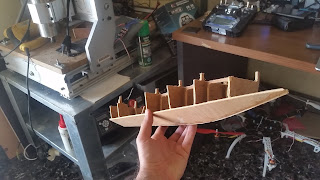14/5/2018
Hello fellow creative persons.
As I was browsing eBay airplanes, I saw a hand thrown foam airplane for $3.83 all together
What came on my mind that moment was Lets build a (kawasaki/monster) rocket (I had most of the parts laying around)
I bought it, and it arrived after a month, which is an ok time for ordering from Greece.
After some playing/hand throwing I realized that I should buy the rest items
I had a quadcopter fpv drone laying around with one broken motor, and I thought that I could use that motor / ESC and the many spare propellers to propel this tiny thing.
I had another quadcopter drone in good condition , but which I don't really use that I could borrow its Receiver (fs-iA6B )
under development yet ..
Hello fellow creative persons.
As I was browsing eBay airplanes, I saw a hand thrown foam airplane for $3.83 all together
What came on my mind that moment was Lets build a (kawasaki/monster) rocket (I had most of the parts laying around)
I bought it, and it arrived after a month, which is an ok time for ordering from Greece.
After some playing/hand throwing I realized that I should buy the rest items
I had a quadcopter fpv drone laying around with one broken motor, and I thought that I could use that motor / ESC and the many spare propellers to propel this tiny thing.
Thats the motor/esc kit i once bought for that drone and now using to build the tiny plane( Multistar 2206 Baby Beast V2 motors / Afro 12A esc )
I had another quadcopter drone in good condition , but which I don't really use that I could borrow its Receiver (fs-iA6B )
The foam is thick and very durable. Also it came with outlined ailerons, (and this saved me some time because it acted like a guide)
which i reamed in v shape on both sides in order to improve the aileron movement.
What gave me problem to work on, was connecting the motor on the plane.
Because I had no motor mount, and because the nose of the plane was not allowing for mounting the motor, I thought that I could buy a small EDF.. but again that would give me hard time and I would need to make a mount. Another idea was to make a mold of the nose and then make a epoxy mount, but that would require lot of time and effort, that i can't provide. So finally I came with the easiest way
I Sliced some of the nose like a cucumber carefully to make it as flat and as vertical to the fuselage as possible.
For motor mount I used a metal sheet / fpv Camera mount that I had laying around, and shaped a bit to match the dimensions of the the airplane. Then, I carefully calibrated the position ( horizontal/vertical position regarded to fuselage and angle) that the mount should be glued. Marked it with a marker and then Hot Glue
Here are the 3.7g Servos, and the patented pushrod
under development yet ..










































